You'll find seven top urban heat mapping techniques that revolutionize temperature analysis from above. Thermal imaging drones capture detailed heat signatures, while LiDAR-based detection offers 3D temperature profiling. Multispectral sensor mapping identifies heat islands across various spectral bands. Infrared camera aerial surveys provide precise, large-scale measurements. Satellite-assisted analysis tracks surface temperatures over time. Machine learning algorithms recognize complex heat patterns, and time-series thermal data collection monitors temperature changes across urban landscapes. These advanced methods empower city planners and researchers to combat rising urban temperatures effectively. Explore further to reveal the full potential of these cutting-edge mapping techniques.
Thermal Imaging Drones
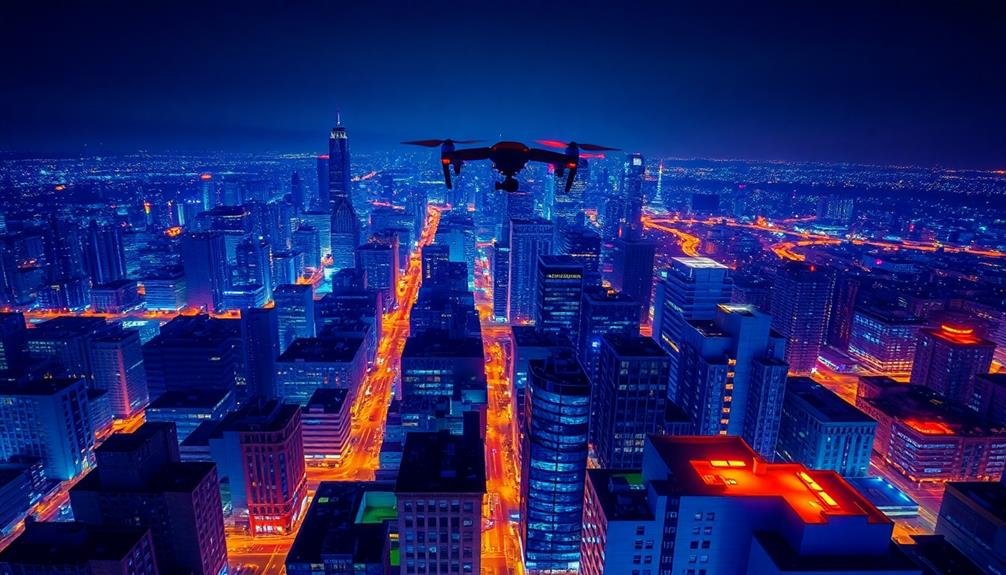
Advancements in drone technology have revolutionized urban heat mapping. Thermal imaging drones now offer you a powerful tool to capture detailed heat signatures across urban landscapes. These unmanned aerial vehicles are equipped with high-resolution thermal cameras that detect infrared radiation emitted by surfaces.
You'll find that thermal imaging drones can cover large areas quickly and efficiently, providing a thorough view of urban heat patterns. They're particularly useful for identifying heat islands, evaluating building energy efficiency, and monitoring temperature variations in different neighborhoods.
When you're using thermal imaging drones, you'll need to take into account factors like flight altitude, time of day, and weather conditions to guarantee accurate data collection. You can program these drones to follow specific flight paths, allowing for consistent and repeatable measurements over time.
The data you collect can be processed into detailed heat maps, revealing temperature variations at a granular level. You'll be able to analyze this information to inform urban planning decisions, guide climate adaptation strategies, and improve residents' quality of life in heat-stressed areas.
With thermal imaging drones, you're equipped to tackle urban heat challenges more effectively than ever before.
LiDAR-Based Heat Detection

LiDAR-based heat detection offers you high-resolution thermal imaging capabilities for urban environments.
You'll benefit from 3D temperature profiling, which provides an extensive view of heat distribution across buildings and structures.
This technology enables you to collect detailed micro-climate data, enhancing your understanding of urban heat islands and their impacts on city dwellers.
High-Resolution Thermal Imaging
Harnessing cutting-edge technology, high-resolution thermal imaging using LiDAR has revolutionized urban heat mapping. You'll find this technique provides unparalleled detail in capturing temperature variations across city landscapes.
By combining LiDAR's precise 3D mapping capabilities with thermal sensors, you can create highly accurate heat maps that reveal hotspots and cool zones within urban environments.
These thermal images offer a resolution as fine as 30 cm per pixel, allowing you to identify heat patterns at the individual building level. You'll be able to detect heat islands, assess the effectiveness of green spaces, and pinpoint areas where heat mitigation strategies are most needed.
The data you gather can inform urban planning decisions, guide the implementation of cooling measures, and help city officials develop targeted interventions to improve residents' comfort and safety during heatwaves.
You'll appreciate how this technology enables you to conduct large-scale surveys quickly and efficiently. By mounting the thermal imaging equipment on aircraft or drones, you can cover extensive urban areas in a single flight, capturing thorough data that would be impossible to collect through ground-based methods alone.
This bird's-eye view provides invaluable insights for addressing urban heat challenges.
3D Temperature Profiling
Building on the high-resolution thermal imaging capabilities, 3D temperature profiling takes urban heat mapping to the next level. By utilizing LiDAR (Light Detection and Ranging) technology, you can create detailed three-dimensional models of urban areas while simultaneously capturing temperature data. This approach allows you to visualize heat distribution across various heights and structures within a city.
When you're employing 3D temperature profiling, you'll benefit from:
- Vertical heat mapping: Analyze temperature variations from street level to rooftops, identifying heat accumulation patterns in tall buildings.
- Microclimate detection: Pinpoint localized hot spots and cool zones within urban canyons and around specific structures.
- Time-based analysis: Track heat retention and dissipation throughout the day, revealing how different materials and surfaces impact urban heat islands.
You'll find that 3D temperature profiling offers unprecedented insights into the complexities of urban heat distribution. By combining spatial and thermal data, you can identify heat-trapping architectural features, optimize green space placement, and develop targeted cooling strategies.
This technique's ability to capture fine-grained temperature variations in three dimensions makes it an invaluable tool for urban planners and environmental researchers alike.
Micro-Climate Data Collection
Delving deeper into urban heat mapping, micro-climate data collection using LiDAR technology offers unparalleled precision in detecting thermal variations. You'll find that LiDAR-based heat detection can capture intricate details of urban heat islands, revealing temperature differences down to the street level.
When you're using LiDAR for micro-climate data collection, you're fundamentally employing laser pulses to create a 3D map of the urban environment. These pulses bounce off surfaces, returning valuable information about the area's thermal properties. You'll be able to identify heat-trapping materials, areas of high solar absorption, and even the impact of vegetation on local temperatures.
To maximize the effectiveness of LiDAR-based heat detection, you'll want to combine it with thermal imaging cameras. This fusion of technologies allows you to create extensive heat maps that showcase temperature variations across different urban structures and materials.
You'll be able to pinpoint hotspots, analyze the effectiveness of cooling strategies, and make data-driven decisions for urban planning and heat mitigation efforts.
Multispectral Sensor Mapping

Multispectral sensor mapping has revolutionized urban heat analysis. You'll find this technique incredibly useful for identifying heat islands and thermal patterns across cities. By capturing data from multiple spectral bands, you're able to gather detailed information about surface temperatures, vegetation health, and urban materials.
When using multispectral sensors for urban heat mapping, you'll typically follow these steps:
- Deploy airborne or satellite-based sensors to collect imagery across various wavelengths.
- Process the raw data to create calibrated spectral bands.
- Apply algorithms to extract temperature and land cover information.
You'll discover that multispectral mapping offers several advantages over traditional methods. It provides higher spatial resolution, allowing you to pinpoint heat sources with greater accuracy.
You can also cover larger areas more efficiently, making it ideal for city-wide assessments.
Infrared Camera Aerial Surveys

You'll find infrared camera aerial surveys to be a powerful tool for urban heat mapping, utilizing thermal imaging technology to detect temperature variations across city landscapes.
When planning these flights, you'll need to take into account factors like ideal time of day, weather conditions, and flight altitude to capture the most accurate thermal data.
Once you've collected the imagery, you'll face data processing challenges such as calibrating the thermal readings and accounting for atmospheric interference to produce reliable heat maps.
Thermal Imaging Technology Explained
At the heart of urban heat mapping lies thermal imaging technology, particularly infrared camera aerial surveys. These cameras detect and measure infrared radiation emitted by objects, which correlates to their temperature. You'll find that this technology allows for precise, large-scale temperature measurements across urban landscapes.
When conducting aerial surveys, you'll typically use specialized thermal cameras mounted on aircraft or drones. These devices capture detailed heat signatures of buildings, roads, and other urban features. The data collected is then processed to create extensive heat maps, revealing temperature variations throughout the city.
To understand how thermal imaging works in urban heat mapping, consider these key points:
- Infrared sensors detect radiation in the 3-14 micrometer wavelength range
- Temperature differences as small as 0.1°C can be distinguished
- Resolution varies, but high-end systems can achieve sub-meter accuracy
You'll find that thermal imaging technology offers several advantages for urban heat mapping. It provides non-contact temperature measurement, works in low-light conditions, and allows for rapid data collection over large areas.
This makes it an invaluable tool for understanding and addressing urban heat island effects in cities worldwide.
Flight Planning Considerations
Successful infrared camera aerial surveys for urban heat mapping depend heavily on meticulous flight planning. You'll need to take into account several key factors to guarantee accurate and thorough data collection.
First, determine the ideal flight altitude. Lower altitudes provide higher resolution but cover less area, while higher altitudes offer broader coverage at the expense of detail. You'll also need to calculate the appropriate overlap between flight paths to guarantee complete coverage and avoid data gaps.
Time your flights carefully. Early morning or late evening flights often yield the best results, as they capture temperature differences most effectively. You'll want to avoid midday flights when solar radiation can interfere with readings.
Take into account weather conditions, too. Clear skies are ideal, as cloud cover can obstruct thermal readings. Wind speed and direction will affect your drone's stability and flight path, so plan accordingly.
Don't forget about local regulations and airspace restrictions. You'll need to obtain necessary permits and adhere to aviation rules.
Data Processing Challenges
Three main challenges arise when processing data from infrared camera aerial surveys for urban heat mapping.
First, you'll need to deal with the sheer volume of data collected during flights. High-resolution thermal imagery can quickly accumulate, requiring substantial storage and processing power. You'll need robust computing systems to handle this data efficiently.
Second, you'll face the task of image calibration and correction. Atmospheric conditions, camera angle variations, and surface emissivity differences can all affect the accuracy of your thermal readings. You'll need to apply complex algorithms to account for these factors and guarantee your temperature measurements are reliable.
Lastly, you'll encounter the challenge of data interpretation and visualization. To make your heat maps meaningful, you'll need to:
- Georeference your thermal images to align with existing maps
- Apply color scales that effectively represent temperature variations
- Integrate other data sources, such as land use information or population density
Overcoming these challenges requires specialized software, expertise in remote sensing techniques, and a deep understanding of urban heat island phenomena.
With the right tools and knowledge, you can transform raw thermal data into valuable insights for urban planning and climate mitigation strategies.
Satellite-Assisted Urban Temperature Analysis

Satellite technology's advancements have revolutionized urban temperature analysis, offering unprecedented insights into heat distribution across cities. You'll find that thermal infrared sensors on satellites can detect surface temperatures with remarkable accuracy, allowing you to create detailed heat maps of entire urban areas.
When you're using satellite data, you'll typically work with products like Landsat or MODIS imagery. These provide thermal bands that capture emitted radiation from the Earth's surface. You'll need to process this data using specialized software to convert it into temperature values.
You can enhance your analysis by combining satellite data with ground-based measurements. This approach helps you validate satellite readings and account for variations in surface emissivity.
You'll also want to take into account the timing of satellite passes, as urban heat patterns change throughout the day.
One of the key advantages you'll find with satellite-assisted analysis is the ability to track changes over time. You can compare images from different years to identify warming trends and assess the effectiveness of heat mitigation strategies.
This temporal aspect is vital for urban planners and policymakers in addressing the urban heat island effect.
Machine Learning Heat Pattern Recognition
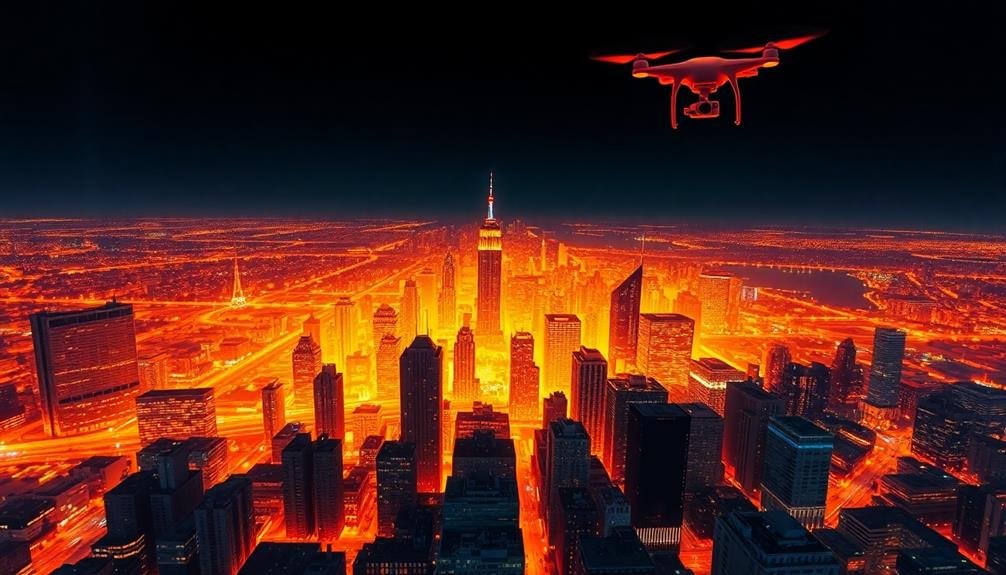
Machine learning algorithms have revolutionized heat pattern recognition in urban environments. These advanced techniques allow you to analyze vast amounts of thermal data quickly and accurately, identifying complex heat patterns that might otherwise go unnoticed.
By training models on historical temperature data, satellite imagery, and urban layout information, you can predict heat island effects and microclimates within cities.
When implementing machine learning for heat pattern recognition, you'll typically follow these steps:
- Data collection and preprocessing
- Feature extraction and selection
- Model training and validation
You'll find that convolutional neural networks (CNNs) are particularly effective for this task, as they excel at recognizing spatial patterns in image data.
By applying CNNs to thermal imagery, you can identify hot spots, track temperature changes over time, and even predict future heat patterns based on urban development plans.
Machine learning also enables you to combine multiple data sources, such as ground-based sensors, satellite imagery, and weather station data, to create more thorough and accurate heat maps.
This integration of diverse data sets allows for a more nuanced understanding of urban heat dynamics, helping city planners and policymakers make informed decisions to mitigate heat-related issues.
Time-Series Thermal Data Collection
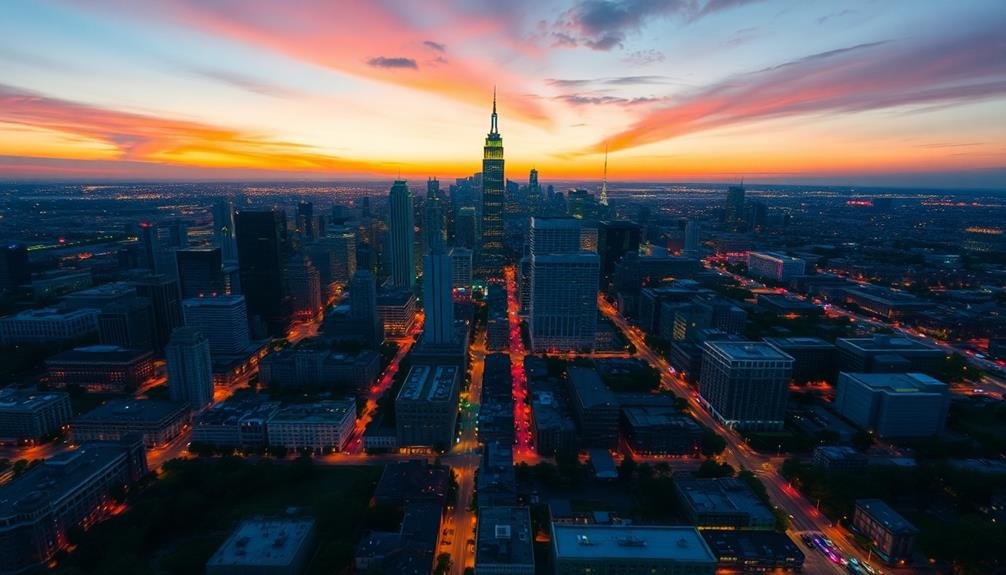
Time-series thermal data collection forms the backbone of extensive urban heat mapping. You'll find this method essential for tracking temperature changes across urban landscapes over extended periods. To implement it effectively, you'll need to deploy thermal sensors or use satellite-based thermal imaging at regular intervals.
When collecting time-series thermal data, you should consider several factors. First, establish a consistent schedule for data capture, whether it's hourly, daily, or seasonal. This consistency allows for accurate trend analysis.
Next, make certain your sensors or imaging equipment maintain calibration throughout the collection period to avoid data discrepancies. You'll want to focus on key urban features like building clusters, green spaces, and industrial zones. By doing so, you'll capture how different urban elements influence heat patterns over time.
Don't forget to account for weather conditions during each data collection point, as they can greatly impact thermal readings.
Once you've gathered your time-series data, you can create dynamic heat maps that show how urban heat islands evolve. This information is invaluable for urban planners and policymakers working to mitigate the effects of urban heat.
Frequently Asked Questions
How Do Atmospheric Conditions Affect the Accuracy of Urban Heat Mapping?
You'll find atmospheric conditions greatly impact urban heat mapping accuracy. Cloud cover, humidity, and air pollution can obscure thermal signatures. Wind patterns affect heat distribution, while temperature inversions may distort readings. Time of day also influences results.
What Is the Cost-Effectiveness of Different Urban Heat Mapping Techniques?
You'll find satellite-based thermal imaging is cost-effective for large areas, while drone surveys offer better resolution at a higher price. Ground-based methods are cheaper but time-consuming. Consider your budget and desired accuracy when choosing a technique.
How Often Should Urban Heat Maps Be Updated for Optimal Relevance?
You should update urban heat maps annually to capture seasonal changes and development impacts. However, if your city's experiencing rapid growth or climate shifts, consider more frequent updates every 6 months for ideal relevance and accuracy.
Can Heat Mapping Techniques Be Combined With Air Quality Monitoring Systems?
Yes, you can combine heat mapping with air quality monitoring. You'll get a thorough view of urban environmental conditions. This integration allows you to track temperature patterns alongside pollutant levels, enhancing your understanding of city-wide health risks.
What Are the Privacy Concerns Associated With High-Resolution Urban Heat Mapping?
You'll face privacy concerns with high-resolution urban heat mapping. It can reveal personal activities, living patterns, and energy usage in homes. You might inadvertently capture sensitive information or enable surveillance of private spaces without consent.
In Summary
You've now got a powerful toolkit for mapping urban heat from above. These seven techniques offer diverse ways to analyze and visualize temperature patterns in cities. Whether you're using drones, satellites, or advanced sensors, you'll be able to identify hotspots and cool zones with precision. Remember, combining methods often yields the most thorough results. By leveraging these technologies, you're better equipped to address urban heat islands and improve city planning for cooler, more livable urban environments.
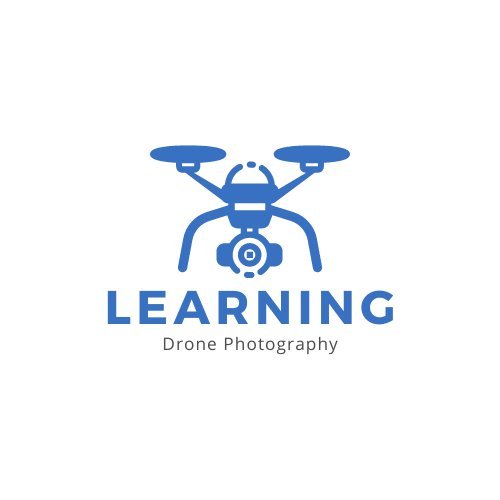
As educators and advocates for responsible drone use, we’re committed to sharing our knowledge and expertise with aspiring aerial photographers.
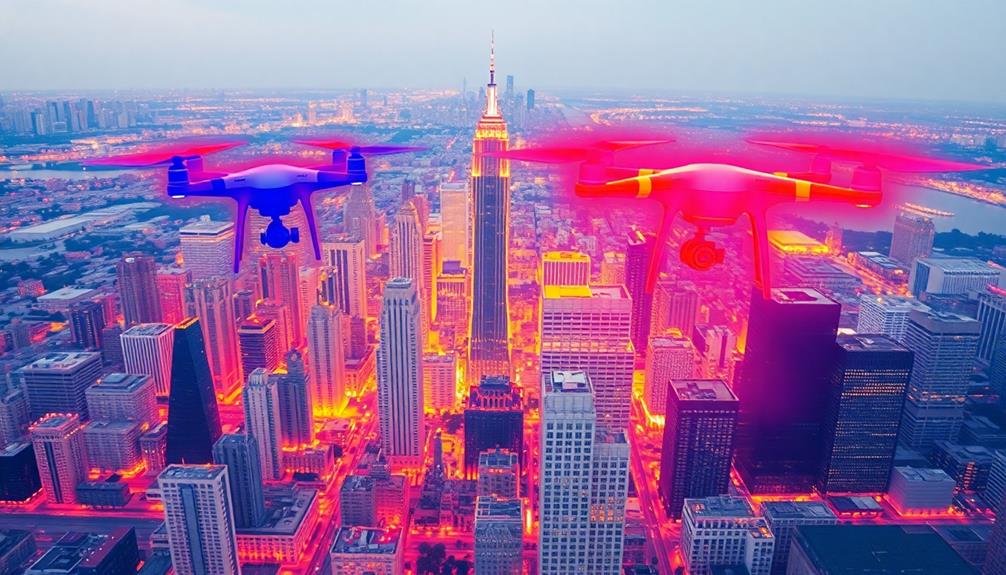
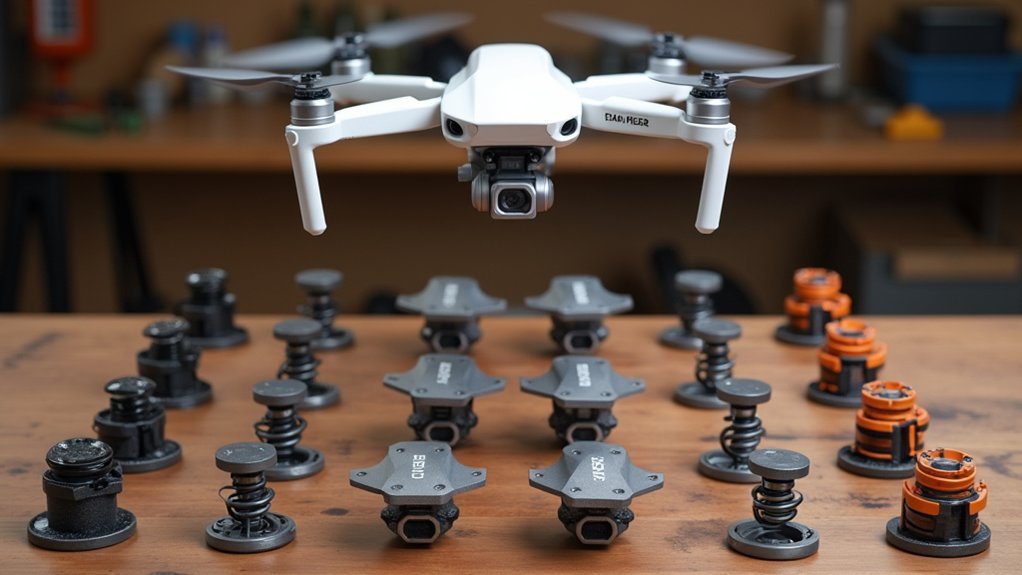
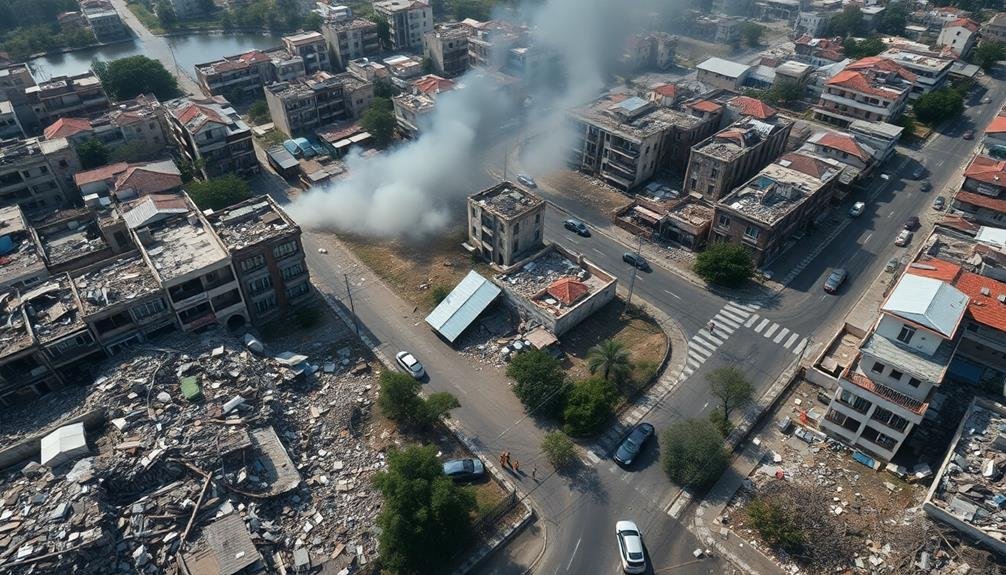
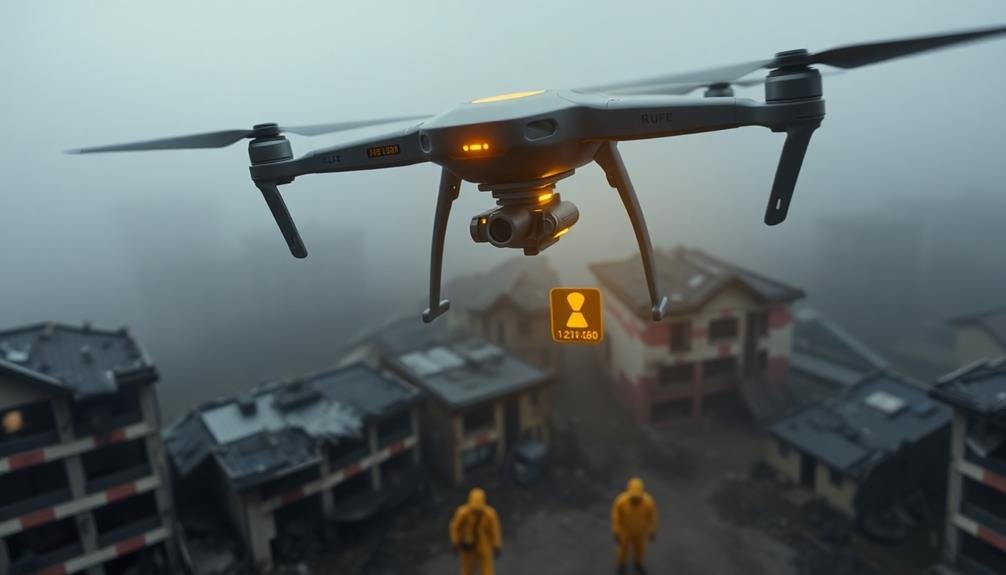
Leave a Reply